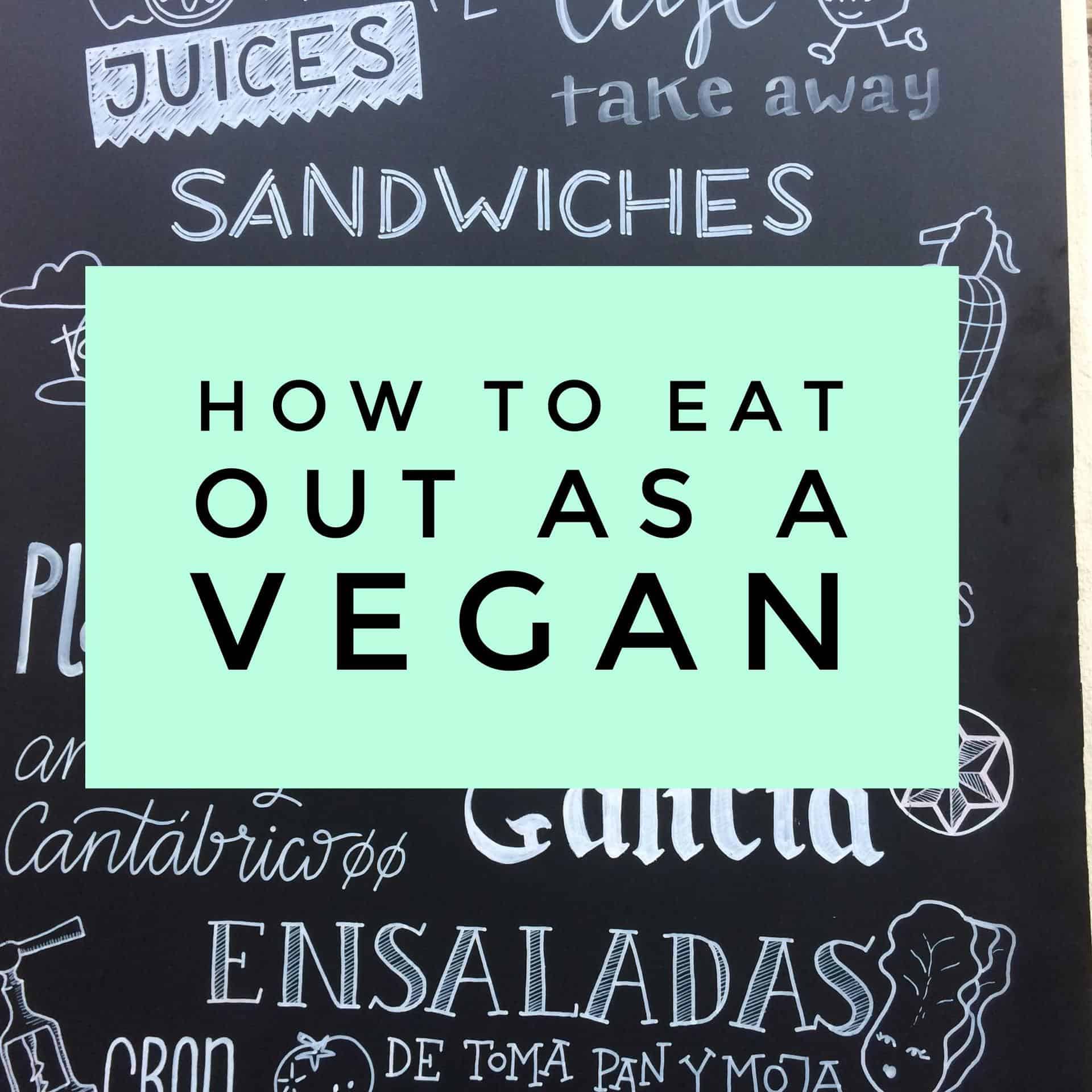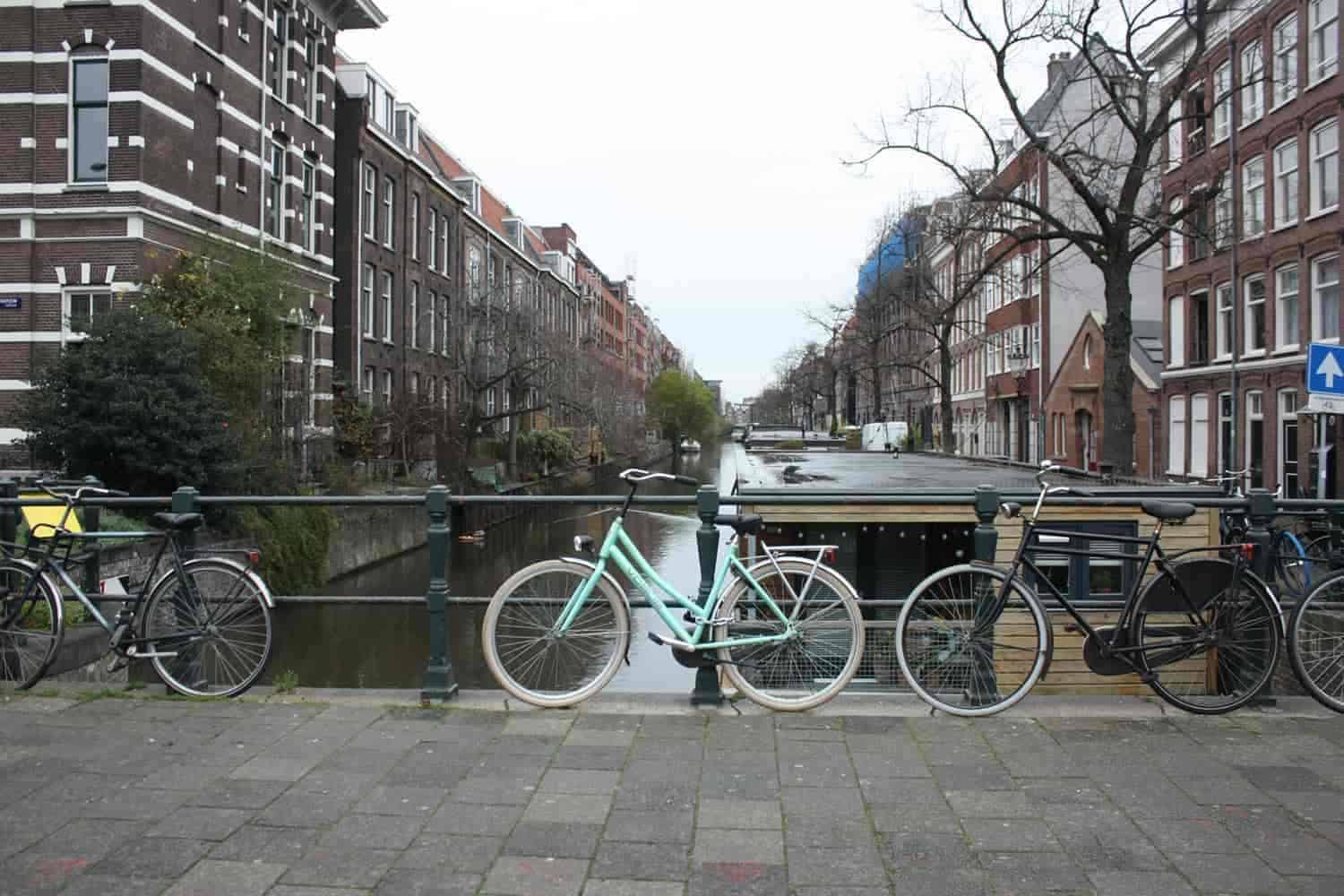“It’s totally vegan. It has just a liiiiiiiiittle bit of egg.”
“Excuse me?” I asked, not believing my ears. “But egg isn’t vegan.”
“Ah, but there’s only a liiiiiittle bit.”
I had this conversation on repeat with a Japanese restaurant. Cue ensuing frustration. Rage. Tears of hanger (hanger=hungry anger, and a dangerous thing).
I always get asked by newbie vegans (and longtime vegans too!) how to order vegan in a restaurant that’s not vegetarian or vegan and doesn’t have vegan options marked on the menu.
In fact, it’s why I wrote my vegan travel guide. Click here to find out more.
It’s also why I put together this guide to eating out as a vegan.
5 Most Important Steps to Getting Vegan Food Anywhere
1. Be patient. You might have to explain a few times what vegan means, and you might have a conversation about how “a liiiiiiittle bit” of egg is not, in fact, vegan. You might also have to wait while your server speaks to the chef.
2. Be appreciative. If they do have vegan options, thank them and make sure you let others know – that way the restaurant will know there is a demand for vegan food!
3. ASK for vegan options. If the restaurant doesn’t have any vegan or veganisable options (rare!) ask them to add some to their menu. If they have dishes that can easily be made vegan, ask them to add a vegan version to the menu!
4. Think outside the box (or burger bun). Seventy-seven percent of Americans report eating world foods when eating out at least once a month, and many world cuisines are much more vegan-friendly than traditional American restaurants. Plus, you get to explore different cuisines
5. Ask the right questions, and know commonly vegan dishes. Don’t just ask “is it vegan?” ask questions specific to the type of cuisine (e.g. “does it contain fish sauce?” in a Thai restaurant or “can you make it without ghee?” in an Indian). That’s where this guide comes in – I’ve included 25+ types of different cuisines, common vegan dishes and questions to ask to get a vegan meal anywhere.
Click here to get your free copy of the email I’ve used to get vegan food at over 100 restaurants!
Below I’ve put together a list of some common restaurant types/cuisines, common vegan dishes and what to ask. Here’s to eating out vegan! I’d love to develop this as a resource so please let me know if you have any additional info about any of these cuisines or any others (comment below or email [email protected]).
How to Order in 25+ Different World Cuisines (Common Vegan Dishes & What to Ask)
Burmese
Look for shan tofu noodle or soup; shan tofu is a tofu made out of chickpeas, tea leaf salad (made with tea leaves – and yes they’re caffeinated, so don’t have this before bedtime) and pennywort salad (a salad made with the pennywort herb).
Chinese
Stir fried vegetables and/or tofu are great bets. Ask if they’re made with fish sauce or oyster sauce, and in the case of mapo tofu make sure they leave out pork as it’s commonly made with it. If you’re ordering vegetable fried rice make sure to ask them to leave out egg. Last, when ordering a noodle dish, just ask them to swap rice noodles for egg noodles.
Cuban
Look for rice and beans (check they’re not made with lard or meat stock) with a side salad or fried banana.
Egyptian
Look for foul/ful (mashed beans often eaten for breakfast) and koshari (a mix of rice, pasta, chickpeas, lentils, noodles and fried onion).
Ethiopian & Eritrean
Ethiopian and Eritrean food are excellent for vegan options because traditional Orthodox Christians “fast” (eat vegan) on Wednesdays, Fridays and special holidays. See if you can get a selection of vegetable curries (make sure they are cooked without dairy) on injera (a special fermented Ethiopian flatbread made with teff flour that’s spongy and lemony and is used as a spoon to scoop up bite of curry). Shiro (chickpea based curry), gomen (greens cooked with spices) and mesir wot (red lentils cooked with berbere spices) are delicious options.
French
French cuisine is notoriously difficult for vegans (and even vegetarians) but look for ratatouille, a classic stewed vegetable dish, olive tapenade made without anchovies or soup au pistou, a Provencal vegetable soup (just check if the pistou – pesto – contains cheese and if so, if they can leave it off).
Greek
Ask if they have “nistisimo” food (or fasting/Lent food, as traditional Greek Orthodox church followers eat vegan during Lent). Most accidentally vegan dishes are found in the mezze section of the menu (mezze are small plates, similar to tapas, and you can make a whole meal out of a few of these, usually without any raised eyebrows). Most food is made with olive oil rather than butter, but always ask if meat stock such as beef or chicken broth is used in cooking. For mezze, look for vine leaves stuffed with rice (make sure they don’t contain or meat stock), fava (split pea dip), briam (eggplant/aubergine, zucchini/courgette, potatoes and peppers cooked in a tomato sauce), Greek salad without feta or gigantes (beans in tomato sauce).
Indian
Indian cuisine is incredibly vegetarian-friendly and with a few tweaks can be made vegan-friendly, too. You’ll want to avoid any dishes with paneer (an Indian cheese), and ask for vegetable curry made without any milk products like cream. In particular ask them if they can cook your food with vegetable oil instead of ghee (clarified butter often used in Indian cooking). Have your curry with a side of boiled basmati rice and opt for chappatti bread (it’s usually milk product free but just check) instead of naan which is almost always made with butter and/or yoghurt.
Indonesian
Try gado gado, vegetables with a peanut sauce (minus the crackers with usually contain fish). Or look for a meat-free nasi goreng, fried rice (but this fried rice is different to any fried rice you’ve had before – it’s normally made with kecap manis, a sweet soy sauce, and served for breakfast). Always ask them to leave out egg and the crackers (which usually contain fish).
Italian
Ask for marinara pizza (a naturally cheese-less pizza topped with just tomato sauce and garlic), or a veggie pizza without cheese, just check the crust is free of milk products. Or ask for pasta; check or ask for dried pasta, NOT fresh (usually contains eggs). Check the sauce doesn’t contain any animal products (sometimes they will add anchovies or pork). Look for pasta alla arrabiata (a spicy tomato-based pasta sauce) which is usually vegan.
Jamaican
Ital food (part of the Rastafarian movement) is almost always vegetarian and usually vegan. Look for boiled green bananas, mango chutney or callaloo, a steamed green.
Japanese
Look for kappa maki (cucumber roll sushi) or avocado maki (avocado roll sushi), and ask for them to leave mayonnaise off the sushi if they use it. Also look for inari, thin fried tofu ‘skin’ stuffed with rice, and edamame, boiled soybeans served with sea salt. Other menu items to look for: miso soup (just make sure they don’t use bonito fish powder), agedashi tofu (deep-fried tofu with a dipping sauce; just check the batter doesn’t contain egg and ask them not to add bonito fish flakes to the dipping sauce or on top of the tofu), gyoza (dumplings; ask if they can stuff them with vegetables and leave out any meat such as pork, also check the dough doesn’t contain egg) and udon noodles (a wide, flat wheat noodle; check the soup stock doesn’t contain any fish or meat).
Kebab shop
Often kebabs have falafel – check if they can make you a falafel wrap (ask if they’ve fried the falafel in separate oil to any meat). Just make sure the bread doesn’t contain dairy and ask them to hold the sauce if it contains dairy.
Korean
Try bibimbap (rice with vegetables and spicy chilli sauce) – just ask them to leave out meat and eggs. Also look for japchae, sweet potato noodles stir fried with vegetables – ask them to leave out meat (it’s often made with pork). Kimchi, a spicy fermented cabbage and vegetable dish often served as a side, sometimes contains fish (oyster sauce, fish sauce or shrimp sauce) so check.
Lebanese (& other Middle Eastern cuisines)
I realise that there are big differences between Middle Eastern cuisines but for our purposes, a lot of Middle Eastern restaurants in the US, UK and Europe (and I imagine Australia and Canada too!) offer many of the same dishes. Look for falafel (spiced chickpea patties), hummus and tabbouleh (a salad made with copious amounts of parsley, bulgar wheat and chopped tomatoes and cucumbers). Other usually vegan options (check they’re made without dairy) include batata harra (spiced potatoes), fattoush salad (a salad with crispy bread topping and lemony dressing) or muhammara (a spicy hot pepper dip found in Syrian and Turkish cuisine).
Malaysian
Malaysian food is a mix of different influences, from Indian to Chinese to European. Try popiah, spring rolls, and for them to be made without meat, shrimp, egg or lard. Also look for meat-free mee goreng, fried noodles, and make sure to specify no egg and ask them to use rice noodles in place of egg noodles. Also keep an eye out for vegan laska, a spicy curry soup (a rarity but worth asking for this delicious dish), without any meat or fish, shrimp paste or fish sauce.
Mexican
The classic vegan option is a meatless burrito with beans (check they’re not made with lard or meat stock), rice (make sure it’s not cooked in chicken stock) and vegetables, hold the cheese and sour cream. Guacamole is traditionally vegan but check (some places add yoghurt or sour cream). When venturing into other territory, such as tostadas, quesadillas or flautas, always make sure no cheese or lard is used. But beyond these ‘standard’ options try some exciting dishes like tacos made with rajas (roasted pepper strips), potatoes, nopales (cactus) or huitlacoche (a fungus that grows on corn and is now considered a delicacy). Just make sure the tacos are made without cheese.
Moroccan
Try zaalouk, a traditional salad made with eggplant/aubergine, tomato and garlic, loubia (white kidney beans cooked in tomato sauce), vegetable tagine and/or vegetable couscous. Just make sure they cook your food with vegetable stock and not meat stock.
Nepalese
Always ask for vegetarian dishes to be prepared without dairy, because dishes are often cooked with ghee (clarified butter) and paneer (a soft cheese) is sometimes always used. Look for vegetable momos, fried dumplings, and dal baht, curried lentils over rice.
Peruvian
Peruvian food is not traditionally very vegetarian- and vegan-friendly, but look for a version of rocotto relleno, stuffed pepper, made with onion and garlic as stuffings (as opposed to cheese or meat), papas a la ocopa (boiled potatoes in a peanut sauce – ask them to hold any cheese which is sometimes served as a side), ensalada de pallares (a butter bean salad – ask them to leave out fish), solterito (a choclo corn salad – ask them to leave out cheese) and sopa de verduras (vegetable soup – just make sure it’s made with vegetable stock and they don’t add any chicken or dried meat).
Pizzeria
Ask for a veggie pizza without cheese (and since they’re taking the cheese off, ask if you can have something extra, like more mushrooms or some walnuts). Check the crust is free of animal products, especially milk products. Avoid pesto (usually contains dairy).
Sandwich/wrap shop
Ask if the bread contains any dairy. Ask for a wrap with vegetables. Ask what sauces they have – if you’re in luck they might have hummus.
Spanish/Tapas
Most dishes are cooked in olive oil (not butter). Look for pimientos de padron (fried peppers with sea salt), tomato bread (crusty bread grilled and rubbed with garlic, tomato and finished with a drizzle of olive oil), gazpacho (cold tomato soup, not a traditional tapa but an excellent vegan Spanish dish), patatas bravas (fried potatoes in a spicy sauce, ask them to hold the alioli as it often contains eggs, and check the bravas sauce doesn’t contain any dairy), escalivada (roasted eggplant/aubergine, onion and peppers on toast) or espinacas con garbanzos (spinach and chickpeas).
Steak house
Yeah, it sounds weird but you can often get a vegan meal here. Ask if they have baked (jacket) potatoes and if their side vegetables, such as broccoli or corn, can be cooked without butter.
Thai
Order a vegetable curry or soup, and just ask them to leave out fish sauce, oyster sauce or shrimp paste. Spring or summer rolls (make sure they’re all vegetable and the dipping sauce doesn’t contain any fish sauce) and raw papaya salad (no fish sauce or dried shrimp) are great options. For pad thai, make sure they leave out the egg.
Vietnamese
Summer rolls (ask for all-vegetable rolls and make sure the dipping sauce doesn’t contain fish sauce) are fantastic, as is pho, a famous Vietnamese soup. Make sure the pho is made with vegetable stock (not a fish or meat stock) and doesn’t contain any fish sauce. Banh mi sandwiches are also delicious vegan options; ask for a tofu or vegetable sandwich without any mayo or fish sauce.
Fast food & chain restaurants
Two more resources you might find helpful:
Fast food & chain restaurants in the US: vegan options
Fast food & chain restaurants in the UK: vegan options
Bonus!
Get a free copy of my email I’ve used to get vegan food at over 100 restaurants. This is the email I send before eating in a restaurant – and it’s ALWAYS gotten me a vegan meal. Click on the button below to get your free copy.













5 thoughts on “How to Eat Out As a Vegan: Vegan Options in 25+ Different Cuisines”
I think one of the things that it took me a while to learn was just to ask – to walk into a restaurant and ask them if they had anything vegan. I don’t know why, I guess I thought they’d shake their fist at me and try and chase the filthy plant eater out. Sometimes they said no. Mostly they said yes, or if not, they’d be happy to make me something, and they were never rude or unpleasant. There are lots of good vegan options out there waiting to be discovered! I am also now in desperate need of bibimbap!
Great resource you’ve put together here Caitlin! I’ve also heard lots of good things about Turkish cuisine, which seems to include many of the same vegan dishes found in Greece.
I’ll admit, some of these things I didn’t know :( :( :(
& Not sure if this was a typo “when ordering a noodle dish, just ask them to swap rice noodles for egg noodles.” shouldn’t it be the other way round?
Super helpful post! Your photos on the rest of the blog are beautiful too. We will bookmark your site. Thanks and keep up the good work Caitlin!
Thanks so much and glad you found it helpful! :D